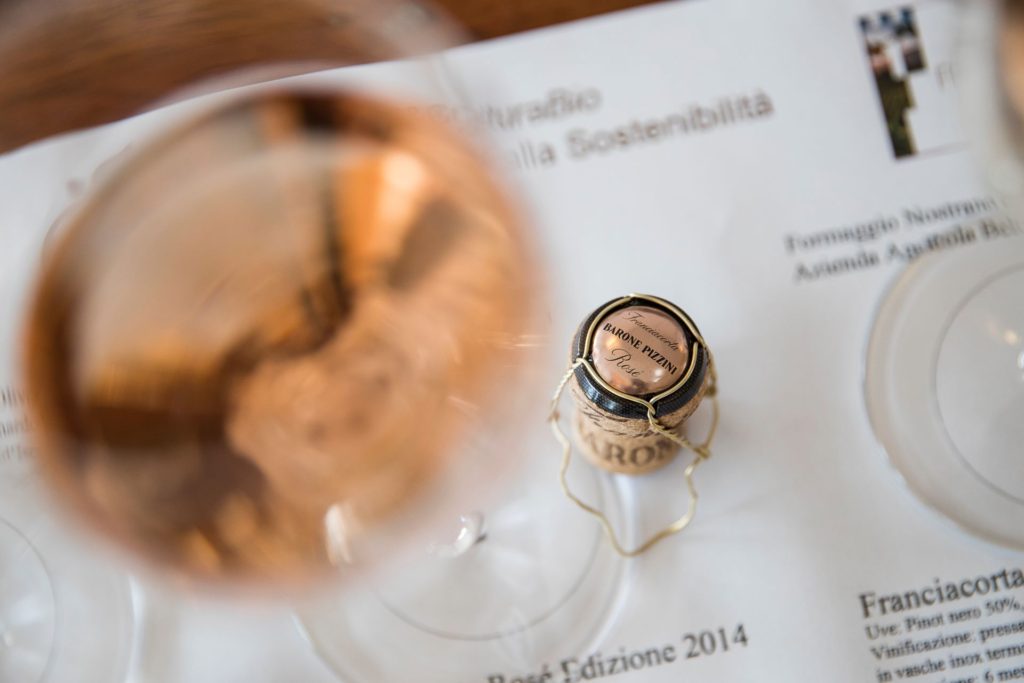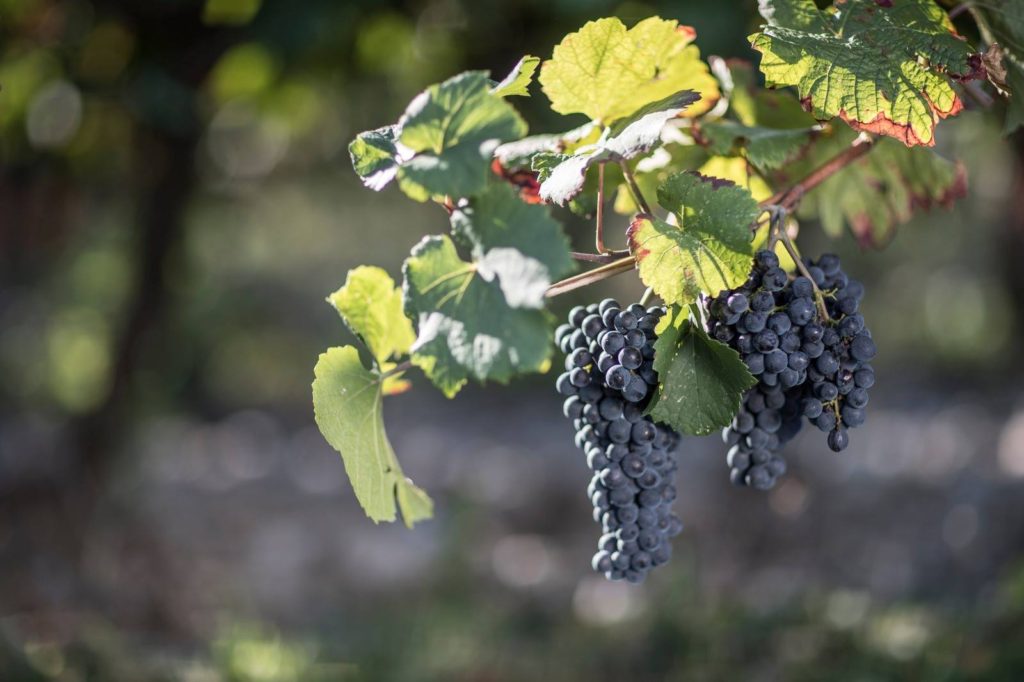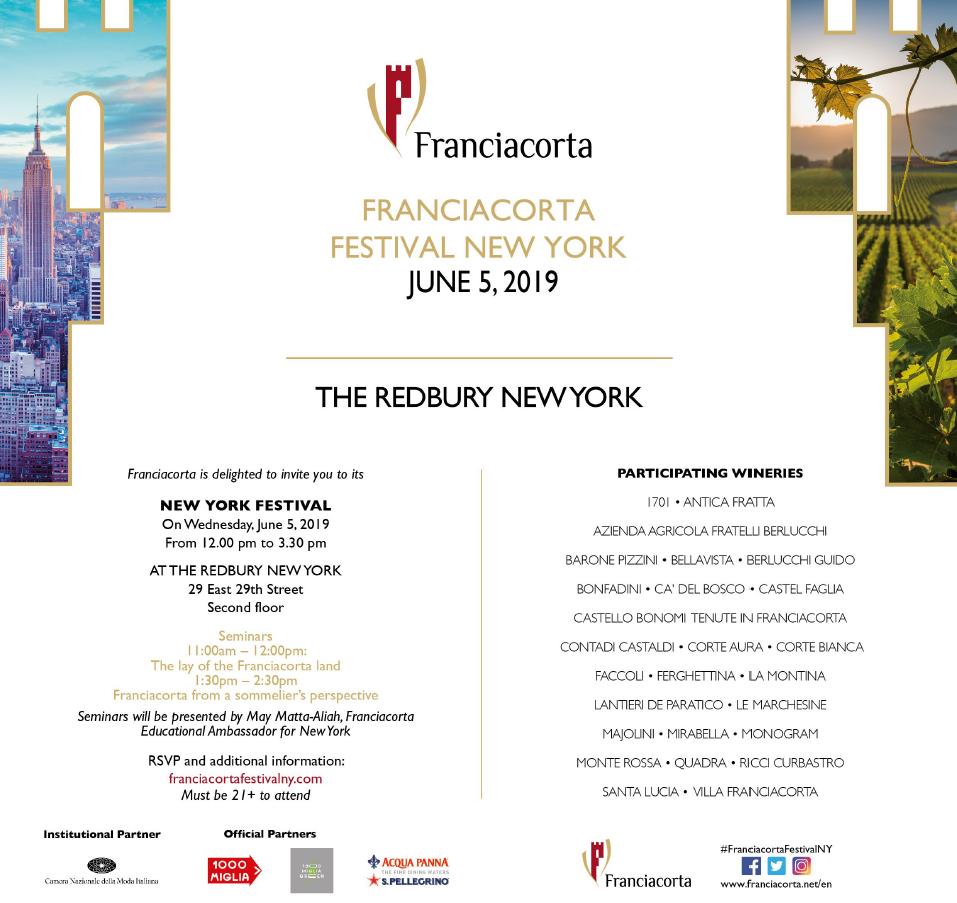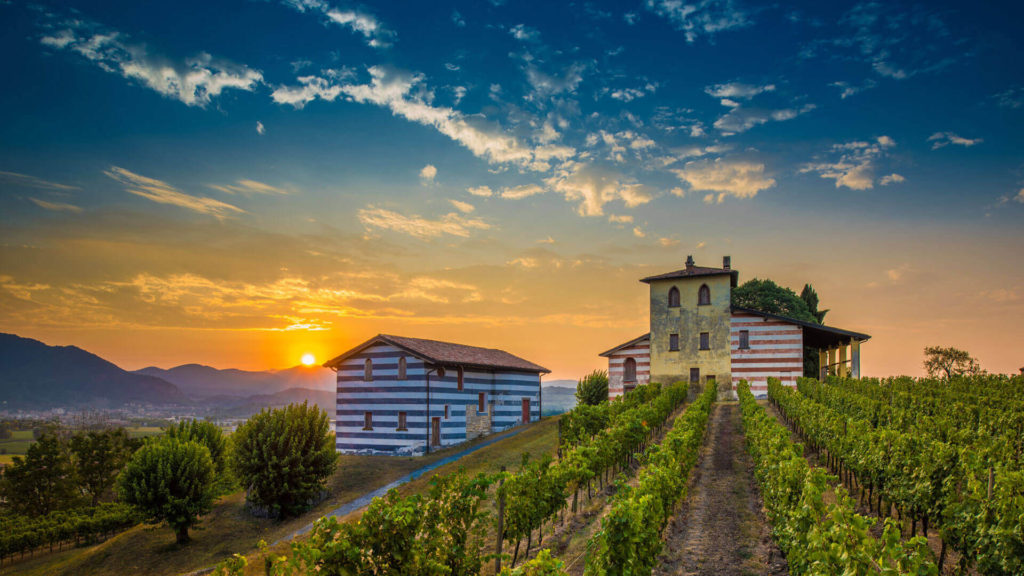It’s officially summer. Sun-soaked beach days (or in our case patios and pools), its time to break out your sundresses, shorts, and suntan lotion. When I think of an epic summer soiree – decadence, luxury, and deliciousness all come to mind. Raw oysters, Maine lobsters, blue crab, finger-licking barbecue, fresh fruits bursting with juicy goodness, and of course bubbles.
It’s no secret fizz and food are BFFs. Sparkling wines with their fine bubbles and brioche-like flavors is delicate yet complex enough, and the racy acidity keeps your palate clean and fresh, especially with rich dishes. Another style that also stands tall to a range of cuisines is the fashionable and currently hot category – Rosé.
Rosé wines boast seductive red fruit, whispers of tannin, and just the right amount of body to please even the snooty red wine drinker. For example, tomato is a red fruit. Wines with red fruit flavors not only compliments a dish made with tomato sauce, the vibrant acidity cuts through the richness of the sauce, that balances both the wine and meal.
Combine the two and you have Sparkling Rosé that magically goes well with almost everything. Its simply one of the best food wines on the planet. Add some chill, these refreshing sparklers are the antidote to blistering summer temperatures, that promises to keep you and your palate fresh as a daisy.

Recently we tasted through every sparkling rosé showcased at Franciacorta’s annual sparkling soiree in NYC – Franciacorta Festival. Before we taste, a quick 101 on how Rosé is made.
Rosé wine can be made in three ways:
Saignee Method: AKA drawing off or bleeding. The most widely utilized method where red grapes (like Pinot Noir) are destemmed and crushed with their grape skins in order to extract their phenolics/color pigment. The intensity of the color desired will determine the length of maceration, which can be anywhere from 6 to 48 hours. To retain fruit aromatics and preserve freshness, this light hued must will be fermented at cooler temperatures and and vinified as a white wine. The resulting rosés are pale, delicate, and acid-driven such as Franciacorta in Italy and Anjou in France.
Direct Pressing: Freshly harvested red grapes will be directly pressed to extract color compounds. Extra care is required to ensure tannin management. Pale pink in color, some examples of direct pressing are the rosé wines of Cotes de Provence and Languedoc.
Blending: An aberration in EU, pink wine is made by blending a small portion of red wine with a white wine, to give it’s color. This process is only allowed in Champagne.
Speaking of sparkling rosé, in particular Franciacorta, to be considered a Franciacorta DOCG Rose, the wine must constitute a minimum of 35% Pinot Nero (Pinot Noir) and age on its lees for a minimum of 24 months via second fermentation in bottle aka traditional method. Lees ageing results in secondary and teritary flavors – pastry, brioche, nuttiness. It also has anti-oxidative properties which means wines remain fresher and vibrant over time. Sweetness levels range from zero dosage to demi-sec (33-50 g/l rs). Our tasting comprised mostly of Brut & Extra Brut.

With most of Franciacorta land dedicated to the golden boy Chardonnay, Pinot Nero is limited to 15% plantings in Franciacorta. And since Franciacorta producers pride themselves for hand-picking only the healthiest and perfectly ripe grapes from the problematic princess Pinot Nero, despite consistently producing more vintage wine than Champagne, not every vintage meets their criteria for producing sparkling rosé.
Add high cost (state of the art equipment designed specifically for rosé production) and risk factors such as maceration, rosé production calls for greater wine-making skill to ensure only the right amount of phenolics are extracted to reach the desired color and flavor profile without pulling coarse tannins. It’s playing Russian roulette to achieve the ideal trifecta of quality, price, and flavor composition. Thankfully for us humble folks, Italian’s are not one to shy away from a challenge not to mention they exude creativity. You can see why Franciacorta rosés are not only coveted, their limited production, and high quality to price ratio makes them even more irresistible.
Shall we taste?
It’s no secret I am an acid freak. That said, being allergic to shellfish, leaves me at a loss to appreciate very high acidity wines. Conceptually, I admire them, but my teeth and body sings another tune. Franciacorta’s warm continental climate, moderated by Lake Iseo and the hills of Monticelli Brusati, Monte Alto and Monte Orfano, allows their grapes to achieve the natural balance of sugar, acidity, and finesse. It’s less tartaric acid, more malic that equates to more fruit, so even the zero dosage or dry sparklers stay fresh, lively, and balanced. Brut can be up to 12 gms residual sugar, but Franciacorta rosé clocking at 3-6 g/l are definitely on the drier side.

Antica Fratta: born on the foundation of the first large scale wine cellar, rescued by one of the founding fathers of Franciacorta – Berlucchi to it’s former glory, Antica Fratta’s Franciacorta Rosé Essence 2014 is a a citrus spiked blend of Pinot and Chardonnay. Expect alluring sweet flowers, whispers of hazelnut, and citrus zest layered with lovely, mouth-filling texture and dry crisp finish.
Grapes: 60% Pinot Nero. 40% Chardonnay. 36 mths lees aging.
Barone Pizzini: Home to the first organic winery in Franciacorta, The organic Franciacorta Rosé 2013 is redolent with bright strawberries & cherries, laced with lemon verbena, soft mousse, ultra fine bubbles and lingering mineral finish. Aged on lees for 30 plus months, it beckons tuna tartare or eggplant caponata to express it’s true potential.
Grapes: 80% Pinot Nero. 20% Chardonnay. 30-40 mths lees aging.
Bellavista Wine: From the house that gave the world the patented style Franciacorta Saten comes the palest red onion hued Franciacorta Rosé, NV, a structured, savory, rich, medium bodied sparkler with undertones of spice and roasted nuts.
Grapes: 38% Pinot Nero. 62% Chardonnay. 38% Pinot Nero.
Did you know Bellavista Winery hand-riddles all of its Franciacorta? That’s 160,000 bottles, 28 days, performed by 2 people. Including performing secondary fermentation in Salmanazar- 9L bottles (only winery in the world). When we visit sparkling wine cellars, quite a few of them have the pupitres showcased up front while in the back most of them are utilizing gyropalette. That’s another reason I admire Franciacorta. Their transparency. When I visited them last spring, the ones using them were extremely proud of them and were happy to chat about their advantages – “It’s a time saver for sure but more importantly provide a consistent wine – a business savvy practice for our consumers who expect nothing less than perfect each year”.
Berlucchi: Homage to the first ever Franciacorta produced – 1961, Franciacorta Rosé 61 sourced from their historic estate vineyard was singing with sweet strawberries, mouth-filling texture, ultra-smooth mousse, and juicy acidity. Not into seafood? This splendid sparkler will work great with fried snacks – arancini, croquettes.
Grapes: 60% Pinot Nero. 40% Chardonnay. 24 mths lees aging.
Bonafidini: An exemplary example of elegance, the Franciacorta Rosé Opera reveals enticing floral aromas blended with sweet baking spices, savory herbal notes with a seductive long finish. Shh, it’s a secret – its my husband’s favorite rose.
Grapes: 50% Pinot Nero. 50% Chardonnay. 24 mth lees aging.

Castello Bonomi: Absolutely sensational – Franciacorta Rosé was humming with strawberries on the nose. Its silky and floral, lush mousse with well integrated bubbles. Umami notes balanced the tangy berry flavors. Beef carpacio is calling our name.
Grape: 100% Pinot Nero. 24 mths lees.
Corte Aura: Bright strawberry and cranberry pop in this gorgeous Franciacorta Rosé. wild herbs, orange zest add layers along with hazelnut and delicate mousse. Heirloom tomatoes sprinkled with basil and sea salt – bring it on!!
Grapes: 75% Pinot Nero. 25% Chardonnay. 24 mths lees.
Corte Bianca: Sourced from organic fruit, Franciacorta Rosé Corte Bianca is a big bold boy that beckons rich dishes such as mushroom risotto or duck stew with rigatoni to balance the meal.
Grape: 100% Pinot Nero. 36 mths lees.
Faccoli Franciacorta: is a small, family run winery (5 ha, old vines 40+), that specializes in vintage wines and super dry bubbles. The Franciacorta Rosé Faccoli is literally spring in a glass. It smells 100% delicious. Lusciously ripe berries balanced with sharp acidity, softy creamy mousse, seriously good. I will take a succulent medium rare rib eye.
Grapes: 60% Pinot Nero. 30% Chardonnay. 10% Pinot Bianco. 24 mths lees.
Ferghettina Franciacorta: One of the emerging estates, founder Roberto Gatti, spent 20 years as cellar-master and viticulturalist at the breathtaking Bellavista, before creating Ferghettina in 1990. The new winery boasts stunning panoromic views of Lake Iseo and Franciacorta. Mr Gatti’s children, both onelogist – Laura and Mathew manage the winery today.
Matthew designed the eye-catching, square-based bottle exclusively for Milledi and Rosé Brut. The triangular, flattened sides provide a surface area around 2.5 times greater than that of a standard bottle, giving more lees to wine contact and therefore greater complexity. The Franciacorta Rosé 2014 is bright, clean, brimming with purity of sweet red berries and ripe apple, with a silky savory finish. I will take an assortment of dim-sum please.
Grape: 100% Pinot Nero. 36 mths.

La Montina: Franciacorta Rosé demi-sec is a perfect example of the harmony between sugar, fruit, and acid. The high acid and lively bubbles work in tangent with the ripe, bright fruit, to uplift are palate without cloying our beings. Bravissimo!!
Grapes: 60% Pinto Nero. 40% Chardonnay. 24 mths lees aging.
Lantieri di Paratico: Also an agriturismo aka wine resort, Franciacorta Rosé Lantieri di Paratico was brilliant – focused, precise, and savory. Impeccably balanced fruit and acid, hints of wild fennel, fine lively bubbles, and a touch of spice. This one guarantees to please even the most discerning bubble devotee.
Grapes: 75% Pinot Nero. 25% Chardonnay 25% 30 mths lees.
Le Marchesine: from the fifth generation family winery comes the racy Franciacorta Rosé Le Marchesine 2015, a delicate blend of Pinot Nero and Chardonnay fermented with natural yeast.
Cantine Majolini: The fashionable house of Majolini, has not only been growing vines since 15th century, they are one of the most progressive producers boasting both certified organic farming and 100% renewable energy. Franciacorta Rosé Brut Majolini danced in the glass with ripe red apples, wild strawberries, soft mousse, and racy acidity. It’s heaven with charcuterie or smoked ribs: the fat/salt of the meats tastes even richer and more decadent with the bubbles.
Grape: 100% Pinot Noir. 24 mths lees aging.
Mirabella Franciacorta: Another house at the forefront of sustainability, Franciacorta Rosé Mirabella exhibited ravishing red berries, cranberry notes, intense, yet fresh and light-footed in each sip.
Grapes: 45% Pinot Nero. 45% Chardonnay. 10% Pinot Bianco. 36 mths lees.

Monte Rossa: A meticulous blend of 12 distinct crus, the Franciacorta Rosé Flamingo is sleek, stylish, mouthwatering bubbles, focused and bright, with elegant perlage. It’s a delightful party starter.
Grapes: 40% Pinot Nero. 60% Chardonnay. 24 mths lees aging.
Quadra Franciacorta: A cheerful charmer, Franciacorta Rosé Quadra even with powerful oak and nutty notes, dances with red fruit flavors brightened with savory lemon. The richness makes it a worthy contender for the entire duration of the meal, not to be dismissed to apertivo time only. (They also produce a vegan Franciacorta).
Grapes: 80% Pinot Nero. 19% Chardonnay. 47 mths lees aging.
Santa Lucia Franciacorta: A berry blast, Francicorta Rosé Santa Lucia 2013 is a sunny sparkler to beat summer blues. At 5 gms of sugar, it’s as dry as a red wine can come, yet leaves you feeling fresh and free.
Grapes: 40% Pinot Nero. 60% Chardonnay. 24 mths lees.
These wines are delicious proof that Franciacorta sparkling rosé are hand-crafted with focus on creating world class sparkling wine with a sense of place beaming with regional character, that are sourced from grapes grown with the utmost care and produced by some of the world’s most skilled wine makers.
Pink wines can be fun and fruity. Complex and intellectual. Delicate and decadent. Add bubbles to the mix, it will turn any weeknight or a simple meal into a special occasion.
Until next time, have a sparkling day!!


